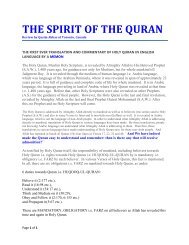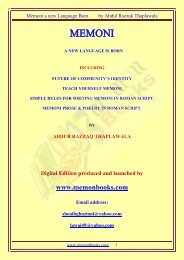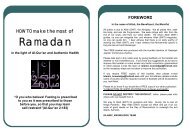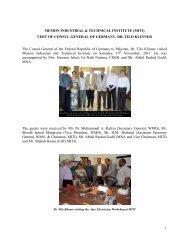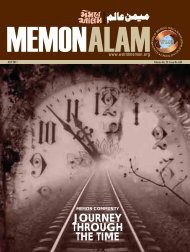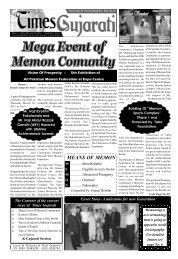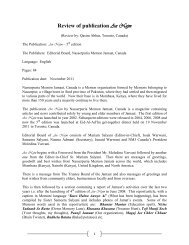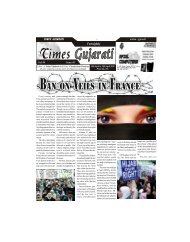February 2012.indd - World Memon Organization Pakistan Chapter
February 2012.indd - World Memon Organization Pakistan Chapter
February 2012.indd - World Memon Organization Pakistan Chapter
- No tags were found...
You also want an ePaper? Increase the reach of your titles
YUMPU automatically turns print PDFs into web optimized ePapers that Google loves.
A REVELATIONheaded by Haji younus Allarakha, were alsoowners of ships that plied regularly betweenIndia and Mauritius.The crew of the Indian artisans, who didthe extension works, was overseen by IshaqMistry, also from India. For the whole durationof the works, the workers stayed on thecompounds of the Mosque “sleeping andeating under the pillared arches of the outercourt.” The project took twenty years to becompleted. The long delay was due either tooutbreaks of disease among the workers orto shortage of materials. However, in 1895,the expansion of the Mosque was completed.Al-Hajj Zakaria Jan Mohammad, aprominent member of the Muslim communityin Port Louis and of the ManagingBoard of the Mosque, supervised the entireexpansion project which saw the smallMosquee des Arabes expand from a smallfringe on Queen Street to occupy the entireblock except for a small section on RoyalStreet, which was leased to businesses forrevenue purposes.The beautiful, small Mosquée-des-Arabesbecame the Jummah Mosque of Mauritius.It is a magnificent work of architectureconspicuous for its bulging domes, welltrimmed arches and white minarets. Theskill and dexterity shown by the workers inblending intricately the old structure withthe new, speak eloquently of “their outstandingability and patience and personaldevotion” to what became, to all involved inthe project, a labour of love. The expansionworks entailed huge expenses which, despitethe tremendous goodwill and generosity40shown by the Muslims at the time to raisethe necessary funds through donations,The Jummah Mosque incorporates elementsof Moorish and Munhal architecture,with its massive columns and imposingarches. In the middle of the open courtstands an old Badamia (Indian Almond orTerminalia Cattapa) Tree, which is olderthan the Mosque itself. In fact, the treealready stood on one of the two originalplots of land on Queen Street acquiredin 1852. The designers of the Mosque, indrawing up the plans of the building, decidedto incorporate the Badamia Tree intothe overall structure of the Mosque. TheTree adds a special charm to the austereplace, its huge branches providing shade toworshipers in the sweltering heat of PortLouis. And, in the evening, on clear starrynights, the prayer hall of the Mosque isthe same vaulted hall of the old Mosquéedes-Arabes.From the towering bulbousdomes, glistening white, hung the brilliantglass chandeliers that provided lighting forover fifty years – that is, till the advent ofelectricity. The beautiful chandeliers can stillbe seen hanging in the prayer hall thoughthe interior is now lit with fluorescent bulbs.The prayer hall is remarkable for its interiorwhich comprises a subtle blend of Arabicand Indian motifs. The Jummah Mosque isa monument to the dedication and religiousfervors of its founders, designers and builders.It has gained in stature over the yearsand has come to hold a special spot in thehearts of the hundreds of Muslims whocome to its vaulted sanctuary every day toworship Allah (God), to meditate and seekinner peace and comfort. As the GrandMosque of Mauritius, the Jummah Mosque,understandably, holds pride of place in thereligious and cultural life of the Muslims.MEMON ALAM FEBRUARY 2012



